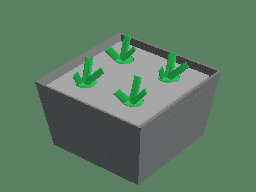 »
The Aeroponics System:
This method is probably the most high-tech type of hydroponics gardening.
Aeroponics Systems use little to no growing medium. The roots hang in the air
and are misted with nutrient solution. The misting are usually done every few
minutes. Because the roots are exposed to the air, the roots will dry out
rapidly if the misting cycles are interrupted.
»
The Aeroponics System:
This method is probably the most high-tech type of hydroponics gardening.
Aeroponics Systems use little to no growing medium. The roots hang in the air
and are misted with nutrient solution. The misting are usually done every few
minutes. Because the roots are exposed to the air, the roots will dry out
rapidly if the misting cycles are interrupted.
A timer controls the nutrient pump much like other types
of hydroponic systems, except the aeroponics system needs a short cycle timer
that runs the pump for a few seconds every couple of minutes. Other types of
Aeroponics systems run constantly, requiring no timer. These systems are easily
contaminated by rot-inducing anaerobic bacteria, and should only be used by
experienced gardeners and researchers.
»
The Deep Water Culture System:
This is the simplest of all active
hydroponics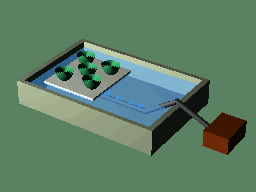 systems. Plants are in a basket of grow rocks, suspended over a container of
aerated nutrient solution. An air pump supplies air to the air stone that
bubbles the nutrient solution and supplies oxygen to the roots of the plants.
systems. Plants are in a basket of grow rocks, suspended over a container of
aerated nutrient solution. An air pump supplies air to the air stone that
bubbles the nutrient solution and supplies oxygen to the roots of the plants.
Water culture is the system of choice for growing leaf
lettuce, which are fast growing water loving plants, making them an ideal choice
for this type of hydroponics system. Very few plants other than lettuce will do
well in this type of system, although it can work well for the vegetative stage
of flowering plants. This type of hydroponics system is great for the classroom
and is popular with teachers.
A very inexpensive system can be made out of an old
aquarium or other water tight container. The biggest draw back of this kind of
system is that it doesn't work well with large plants or with long-term plants.
»
The Drip System: This method is
probably the most widely used type of hydroponic system in the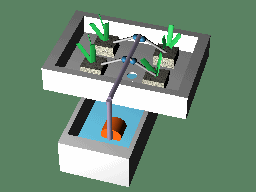 world. Operation is simple, a timer controls a submersed pump. The timer turns
the pump on and nutrient solution is dripped onto the base of each plant by a
small drip line.
world. Operation is simple, a timer controls a submersed pump. The timer turns
the pump on and nutrient solution is dripped onto the base of each plant by a
small drip line.
In a Recirculating Drip System the runoff is collected
back in the reservoir for re-use. The Water-to-Waste System does not collect the
runoff. The advantage of Water-to-Waste is that the nutrient solution in the
reservoir has never passed through the system, so it is unchanged. In a
Recirculating System, the nutrient solution can fluctuate in both nutrient
concentration levels and pH levels.
We recommend a soilless mix for Water-to-Waste systems,
because soilless mixes retain more water. This way, the pump kicks on less
often, so you use less nutrient solution. With quality nutrients and a good
soilless mix, a Water-to-Waste Drip System can be one of the best ways of
gardening with lights.
» The
Ebb and Flow System:
Ebb and Flow works by temporarily flooding the grow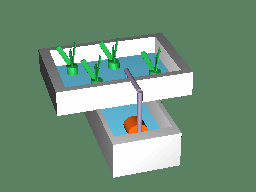 tray with nutrient solution and then draining the solution back into the
reservoir. This action is normally done with a submerged pump that is connected
to a timer. When the timer turns the pump on nutrient solution is pumped into
the grow tray. When the timer shuts the pump off the nutrient solution flows
back into the reservoir. Depending on plant requirements, the tray can be
flooded once, or several times, each day.
tray with nutrient solution and then draining the solution back into the
reservoir. This action is normally done with a submerged pump that is connected
to a timer. When the timer turns the pump on nutrient solution is pumped into
the grow tray. When the timer shuts the pump off the nutrient solution flows
back into the reservoir. Depending on plant requirements, the tray can be
flooded once, or several times, each day.
The main disadvantage of this type of system is that with
some loose types of growing medium (Growrocks, Perlite, etc.), there is a
vulnerability to power outages as well as pump and timer failures. The roots can
dry out quickly when the watering cycles are interrupted. This problem can be
relieved somewhat by using growing media that retains more water (Rockwool,
coconut fiber or a good soilless mix).
This is the system we often recommend for first-time
hydroponics gardeners. It is simple, reliable, and easy to set up.
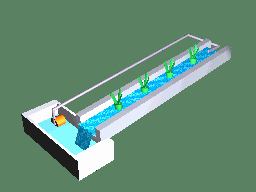 »
The N.F.T. System:
N.F.T. systems have a constant flow of nutrient solution so no timer is required
for the submersible pump. The nutrient solution is pumped into the growing tray
(usually a tube) and flows over the roots of the plants, and then drains back
into the reservoir.
»
The N.F.T. System:
N.F.T. systems have a constant flow of nutrient solution so no timer is required
for the submersible pump. The nutrient solution is pumped into the growing tray
(usually a tube) and flows over the roots of the plants, and then drains back
into the reservoir.
Normally the plant is supported in a small plastic basket
full of grow rocks, with the roots dangling into the nutrient solution. N.F.T.
systems are very susceptible to power outages and pump failures. The roots dry
out very rapidly when the flow of nutrient solution is interrupted.
There is usually no growing medium used other than air,
which saves the expense of replacing the growing medium after every crop.
Normally the plant is supported in a small plastic basket with the roots
dangling into the nutrient solution.
»
The Passive System:
This is almost identical to growing a plant in a container of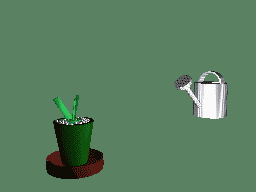 soil. The difference is that instead of soil, you would use a soilless mix.
Soilless mixes can be a variety of substances including rockwool, peat moss,
coconut coir, perlite, vermiculite, tree bark, etc.
soil. The difference is that instead of soil, you would use a soilless mix.
Soilless mixes can be a variety of substances including rockwool, peat moss,
coconut coir, perlite, vermiculite, tree bark, etc.
»
The Wick System: This is by far
the simplest type of hydroponics system. This is a passive system, which means
there are no moving parts. The nutrient solution is drawn into the growing
medium from the reservoir with a wick. This system can use a variety of growing
mediums. Perlite, Vermiculite, Pro-Mix and Coconut Fiber are among the most
popular.
The biggest draw back of this system is that plants that
are large or use large amounts of water may use up the nutrient solution faster
than the wick(s) can supply it.
 »
The Aeroponics System:
This method is probably the most high-tech type of hydroponics gardening.
Aeroponics Systems use little to no growing medium. The roots hang in the air
and are misted with nutrient solution. The misting are usually done every few
minutes. Because the roots are exposed to the air, the roots will dry out
rapidly if the misting cycles are interrupted.
»
The Aeroponics System:
This method is probably the most high-tech type of hydroponics gardening.
Aeroponics Systems use little to no growing medium. The roots hang in the air
and are misted with nutrient solution. The misting are usually done every few
minutes. Because the roots are exposed to the air, the roots will dry out
rapidly if the misting cycles are interrupted. 



